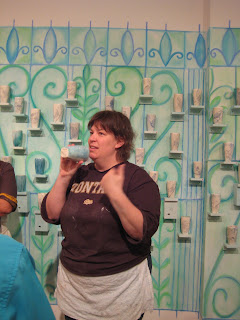
My birthday was on Sunday, and, as a present to myself, I got my shift covered at work so that I was able to assist and attend a workshop with
Julia Galloway at
The Clay Studio last weekend.
Although the title of the workshop was "Porcelain Surfaces", to me, it seemed more a presentation of ways to reconceptualize pots. Through hands-on exercises, slides, and discussion she offered a variety of entry points with which to think and re-think pots.
For example, early on, she had everyone take a lump of clay and form it into a pear. Then the pears were literally deconstructed when she said to take a wire and make one cut into the pear, then rearrange the pieces. From this single action, she had us see the creation of a line and a

plane, and start to gather information from these. She also looked at the rearrangements and read narratives from them, which in turn suggested the functionality of the piece (like maybe you could say two parts are cradling each other, and could lead to a cup and saucer set).
She often uses metaphor to talk about form and functional. She looks at a sugarbowl as something to "hold sweetness" and perhaps this is why she created some sugar/creamer sets that look like little beds. The sugar is stored underneath the pillow and it is nice to think of the sweetness being held by your pillow, and evokes the phrase "sweet dreams".
We looked at slides of historical pots and she pointed out how culture and values of a region can be expressed thoroughly through a pot. Different cultures even seem to have specific vectors in their pots. European pots seem to be headed Up and Islamic pots seem to be headed Out, while Chinese pots are "inhaling, and settling".

Later in the day she addressed surface decoration more directly, in a rather declarative moment that had us all scrambling for our notebooks for the truthbomb she was about to drop: all surface decoration resolves to just 4 things: dots. lines. flora. representation. We did a hands-on exercise playing with these four simple modes on porcelain tiles.
She said that you could see the form of a pot as its emotional content, while its surface provides its intellect. That made sense to me. But I wonder what it means that I find surface decoration so challenging. Usually my attempts at it seem so cheesy, or cutesy, or overly earnest. Can the same be said of my intellectual expression?
We heard a story about how she got clues on how to glaze by taking notes on the daily outfits of one of her better-dressed professors. As she says it on her website, "We put all kinds of colors and textures together when we get dressed every morning, and when it comes to glazing, I think this is a good place to start."
Even her midday lecture was not only a description of her work, but again, an offering of entry points into how she sees ceramics, art, artists. I think she might say an artist's work is ultimately a way to explore and celebrate her world. In Julia's case, she explores and celebrates beauty she sees, passion and obsessiveness, sense of place.

The show that she had spent the week installing in The Clay Studio's gallery,
Quiescent, is a kind of homage to John James Audubon and his watercolor paintings of “The Birds of North America”, and is a reflection of these three things. She celebrates the beauty of his paintings, but she also really relates to his passion for his work. She pointed out that later in his life, when he realized he would not live long enough to document every bird, he started working with BOTH hands, and that level of obsession resonated with her. The installation itself suggests an enclosed garden, a quiet space. The walls are covered with bird cups, one for every bird that Audubon identified and painted. Some sit on shelves that emit birdsongs when you walk by. I think she's trying to recreate those moments outdoors where you feel totally present in the powerful stillness in between the birds calling.
She also showed other students' work in her lecture. She obviously loves seeing how these developing artists are also exploring and celebrating their worlds.

In her lecture she mentioned that she began teaching workshops in art centers in a conscious effort to offer something to community artists- the "weekend warriors"- recognizing that when your time in the studio is limited, you tend to focus on technique. Workshops are a way to bring the conceptualizing, the metaphor, the theorizing, to the work.
I realized when she said this that I had taken it for granted that this kind of knowledge would always be accessible. But in fact, I rely on artists like her being generous and enthusiastic enough to share, and I thank her for spending the day with us, lending her experience and insight.






